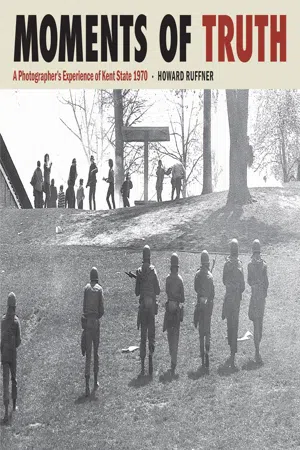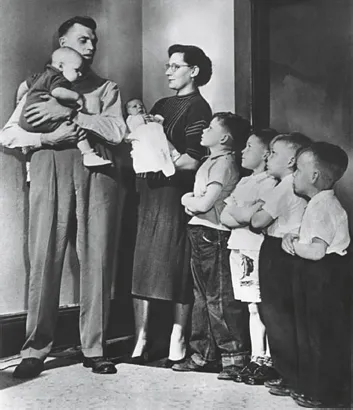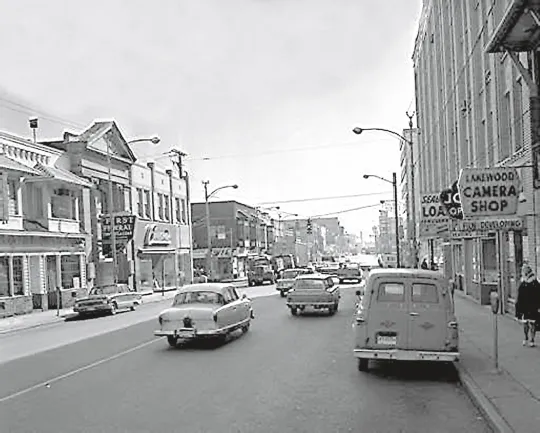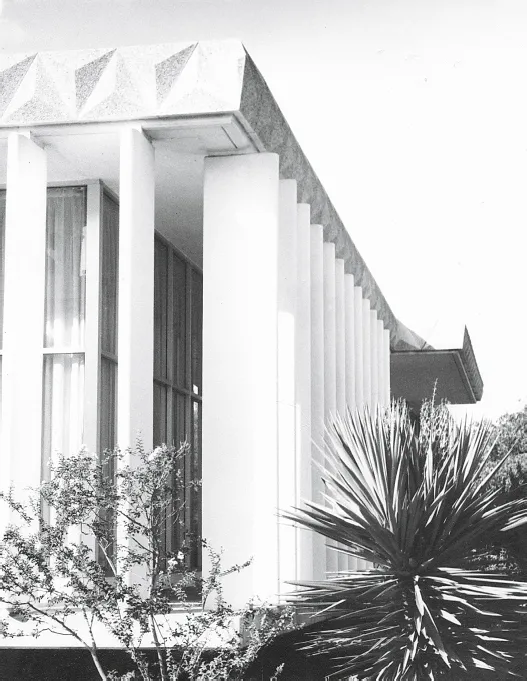![]()
EARLY EXPOSURE TO THE
POWER OF PHOTOGRAPHS |
1 |
That’s me in the photo (1) standing next to Mom, looking up at my newest brother, Ric. The Cleveland Press thought a family of six boys made for a good human-interest story. They sent a photographer to our home to capture an image of us. I saw the photographer come into our house. He looked around for a place to gather us. He positioned us and took the picture. The photo ran on the front page of the afternoon paper the next day. Friends and neighbors couldn’t wait to share this front page. We were famous. Years later I contacted the photographer and talked about the photo and told him about Mic being number seven. He graciously gave me an 11 x 14 print that we have shared with the family. Obviously, I saved it all these years.
Photo 1. My mother holds the newest addition to our family, my brother Ric. This photo appeared on the front page of the Cleveland Press in 1953 with the headline: “Sing a song of six pants, a pocket full of boys.” From left: Dad (Howard) holding Ron, Ric held by Mom (June), me, Tom, Bob, and Donn. (Photo by Clayton Knipper. Courtesy The Cleveland Press Collection. Special Collections, Michael Schwartz Library, Cleveland State University.)
Family pictures are remarkably powerful. As my eyes wander from brother to brother in Photo 2, I see the strength of our brotherhood; at the same time, I remember the struggles and the many joys we shared. We laughed and cried. We finished school, and we each had our own special talents. Photographs are personal. The longer I stare, the more I see. As I look at us, I see a truth hiding in each of us. Tom has a confident look; he was a successful graphic designer. The faraway look in Bob’s face reminds me he had just returned from two tours in Vietnam. Donn flashes a peace symbol, but I know it hides the depression that caused his suicide many years later. Ron stands a little separate from the group, always apart. He now lives in Kuala Lumpur, much farther away, with little family contact. Ric was the all-American boy. At 22 he announced he was gay—but we already knew. Mic stands there at 16, still finding his way. He now finds peace in his Christian faith. Photography is my way of looking at my brothers and the world. Every photo is more than its surface. Each tells a story. The more I stare, the more I see the truth in the photos I take.
Photo 2. October 1970. I am 24; my youngest brother is 16. I look now at our clothes and remember the crazy times. Donn and Tom have passed, but when I look at this photograph, they are as present with me today as they were then. From left to right: Mic, Ric, Ron, Donn, Bob, Tom, and me.
As young men without the money to go to college, we were all draftable. I graduated from high school in 1964 and the Vietnam War was on TV every night. I attended a branch of Ohio State University, but my GPA wasn’t high enough to continue. I made the decision to join the air force because that seemed safer. I figured four years in the air force was safer than two in the army. Donn and Ron also joined the air force, while Ric joined the navy. Bob, however, was braver. He and a friend enlisted in the army for three years. Bob served two years in the jungles of Vietnam and then got an early out.
My only introduction to photography was working at Lakewood Camera Shop after school (Photo 3). I checked in new cameras and placed a store sticker for advertising under the film spool. During the year I worked there, I never took even one picture nor did I load a camera with film. Customers brought in film to develop, and I filled out the Kodak yellow bag to be picked up and processed. Working there, I was exposed to hundreds of photographs every day. I watched customers’ expressions as they opened their envelope of pictures. I witnessed the transforming power the photographs had as they smiled, laughed, or just looked. There was no question that these photographs had meaning beyond the processed image.
Photo 3. Lakewood Camera Shop was one of three neighborhood stores where I worked while in high school. This is Lakewood in 1965 with the camera shop on the right. I see myself in this picture as I walked to work every day after school. Within the same block, I also worked at a toy store and a shoe store. (Courtesy of The Cleveland Memory Project)
After graduating from high school, I worked full-time for the Continental National Insurance Agency in the mailroom. In the fall I took a position with the Norfolk and Western Railway as a book binder in its accounting department. When work finished at the railroad, I could be found working the cash register at Marshall’s Drug Store until closing, around 9 P.M. On weekends I worked at Miller United shoe store where I had worked in high school.
These jobs gave me steady paychecks and kept me busy. However, I had absolutely no connection to cameras or photography. As the antiwar sentiment was growing, I felt increasingly stuck in Lakewood, Ohio.
Then one spring evening a high school friend, Eric Benz, asked me, “Why don’t you join the air force with me on the Buddy Program?” It took me only a half second to reply, “Sure, that sounds great!” The next day I went to the recruiter, took some tests, and enlisted. On May 11, 1965, I flew to Lackland Air Force Base in San Antonio, Texas, for basic training.
![]()
AIR FORCE PROVIDES
FORMAL TRAINING | 2 |
May 11, 1965, I saw bright sunshine and waves of heat as my squad landed on the tarmac at Lackland Air Force Base in San Antonio, Texas. It was the first time I ever flew on a plane, and I was white-knuckled and terrified yet excited. I was squad leader for our group from Cleveland and carried everyone’s enlistment papers ready to hand off to the officer in charge. I felt the hot, humid Texas air and knew for sure I wasn’t in Lakewood anymore. I honestly welcomed the rigors of basic training. I felt relieved not to be working three jobs along with the pressures of living at home.
Two months before I enlisted, 3,500 marines were sent to South Vietnam. These were the first combat troops assigned there. At that time, a majority of US citizens and a majority of Congress favored this war. In fact, Operation Rolling Thunder was launched by Gen. William Westmoreland while I was in basic, and he sent an additional 125,000 troops into combat. Meanwhile, race riots happened in the Watts section of Los Angeles. These facts had little impact on me. While all this was happening, I was marching in the hot Texas sun to become an airman. Early in the morning, while on KP, I would sit on the back steps of the kitchen and peel potatoes, listening to Jimmy Gilmer and Fireballs sing “Sugar Shack.”
“Hey, Ruffner, how many days ya got left?” I heard that nearly every day during basic training at Lackland. I already was counting down the days until college; every guy in my squad knew it and ribbed me. I planned to use the GI Bill to go to Kent State when I got out—in four years. Kent was a state school with a good radio and television program. That goal kept me focused.
On the last day of basic, we huddled in the dayroom of our barracks. This was the moment of truth. We had no idea where we would be assigned. The sergeant read our names and assignments. Instead of a school, I was sent directly to the headquarters of Twelfth Air Force (12 AF) in Waco, Texas, as a writer in the information office. This was the Tactical Air Command Headquarters commanded by Gen. Lucius D. Clay Jr. Air force fighter jets west of the Mississippi River were sent to Vietnam from this headquarters.
Photo 4. Forty-eight airmen graduated basic training in June 1965. I’m on the far right in the back row. Looking at this, I’m reminded of the day I made a decision that changed my life. Like the other young men in the picture, we made a choice to change, each one of us together, each one of us for different reasons, and each on our own unique journey. We were not the same young men who entered this base eight weeks prior. We were smiling because we survived and graduated. (USAF photo)
After a short leave at home, I arrived at James Connally Air Force Base in Waco, Texas. This is where I lived over the next two years. Every morning an air force blue bus took a group of us from the base to headquarters 12 AF in downtown Waco. It was during my two years there when I discovered photography would be a part of my life.
Staff Sergeant Kuepper, our staff photographer, got me started in photography. Kuepper took the portraits of servicemen and women returning from Vietnam, and I wrote the news releases for “home town” newspapers. Kuepper sensed I was interested in photography and taught me some of the basics so I could take portraits. I learned to use his 4 x 5 Speed Graphic. It was big and bulky and used a 4 x 5 film holder. With Kuepper’s advice and recommendations as to what features would be best for me, I bought my first camera: his used 35 mm Praktina FX (Photo 5). I paid about $35 for it, and, for a little more, I added several lenses, including a huge 400 mm. I’m sure he was only unloading an old camera of his, but I was just thrilled to have a camera of my own that I could afford.
Photo 5. The Praktina FX was my first camera. It was an early 35 mm single-lens reflex (SLR) camera with interchangeable lenses, a removable viewfinder, and a camera back. It was the first SLR to automatically close the diaphragm to the preselected aperture. (Wikimedia/Creative Commons)
This was a basic and inexpensive camera. Nothing about the Praktina was automatic. I turned the knob to advance the film, had to check my light meter, then set the f-stop and shutter speed. Focus was manual with a focusing screen in the viewfinder. I had wide-angle and telephoto lenses. On my time off I would shoot a roll of film and get it developed. Some days I would take one lens and a roll of film and practice visualizing before I snapped the picture. Kuepper critiqued my pictures and offered advice. Once I learned the mechanics of taking a picture, I had more time to create images as I saw them. Every captured image helped me see the world in new and exciting ways. For me, that was the power of photography. What I captured at a moment in time was the truth at that instant, nothing more and nothing less.
After a year of taking pictures I made my first 8 x 10 print (Photo 6). Kuepper taught me about looking for the light and how it shaped objects. I began looking more for light than subjects. While in downtown Waco, I saw how the light played on this building. The light gave shape to the columns and texture to the granite surrounding the top of the building. The cactus came alive with sunlight and shadows reflecting off its leaves. Of course, it is just a building and a cactus, but it became a powerful photograph when I realized what I was able to capture.
Photo 6. This was the first photo I felt worthy of enlarging. It captured just what I saw. I liked the composition and lighting and decided to blow it up to 8 x 10 inches.
While in Waco, I applied and was accepted to the Department of Defense Broadcast Specialist Course at Fort Benjamin Harrison in Indianapolis, Indiana. This was an eight-week course in journalism and broa...






